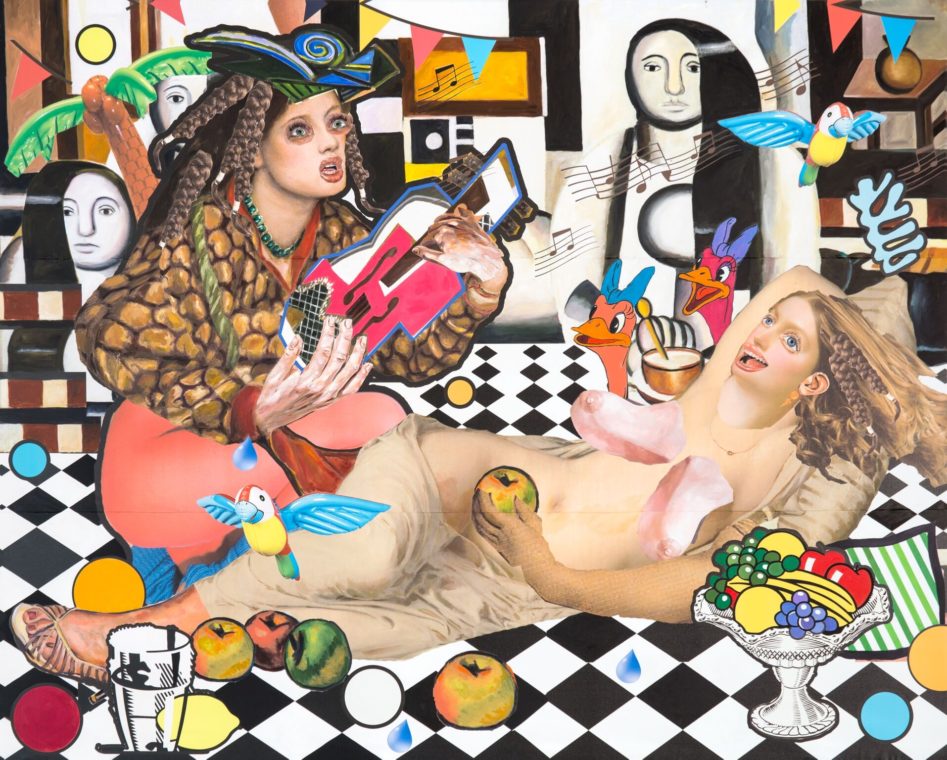The young painter, no, the remixed-media collage artist or better yet, the hyper-meta art cannon image sampler, Allison Zuckerman, who experienced a wild, meteoric rise in the contemporary art world over the last year and a half, is ready to embark on the next and sure to be exciting chapter of her life and career.
Last week, just one day after her 28thbirthday (“I missed the 27 Club.”), she joined her criminally under-celebrated but always-fun art dealer, Marc Wehby, for a chat in her new studio, which is right around the corner from the 56 Bogart gallery complex in Bushwick.
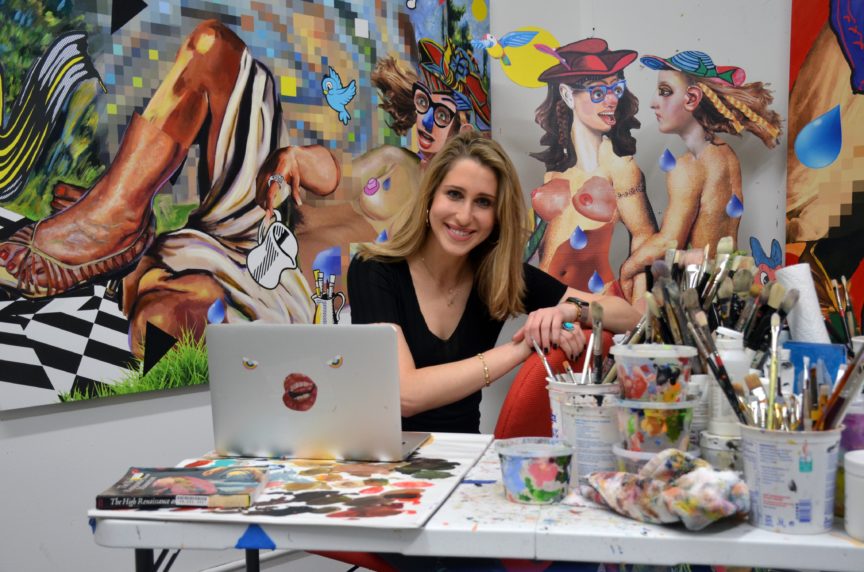
Allison Zuckerman in her Brooklyn studio. Image courtesy of the artist
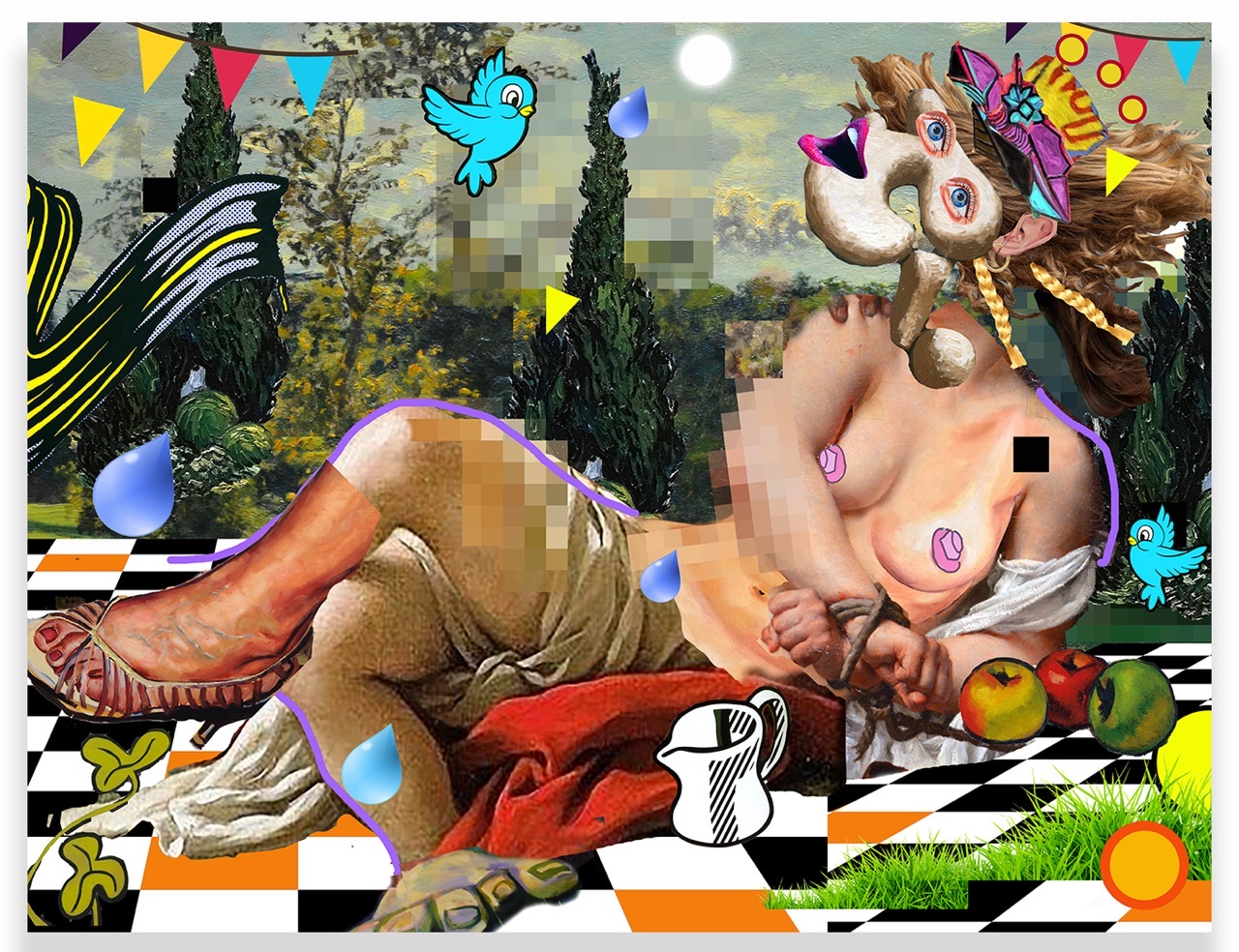
Allison Zuckerman, Nude Before Nightfall, 2018, acrylic and archival CMYK ink on canvas, 48 x 63″
“I’ve been a dealer since 1989 and I’ve literally never had an experience like this before,” says Wehby, engulfed by Zuckerman’s fantastically scatterbrained sculptural chimeras.
Kravets Wehby Gallery, it must be noted, is a mid-size, ground floor gem on 21st Street in Chelsea, which Wehby runs with his wife, Susan Kravets. It could also be noted, that Mrs. Kravets and Mr. Wehby aren’t completely unaccustomed to discovering and launching young female art stars, but that’s another story.
“We’re getting people’s attention from every facet of the art world,” Wehby continues, before offering up a list of upcoming brands, museums, foundations and other obvious and equally surprising entities that want a piece of Allison and her literally eye-popping work.
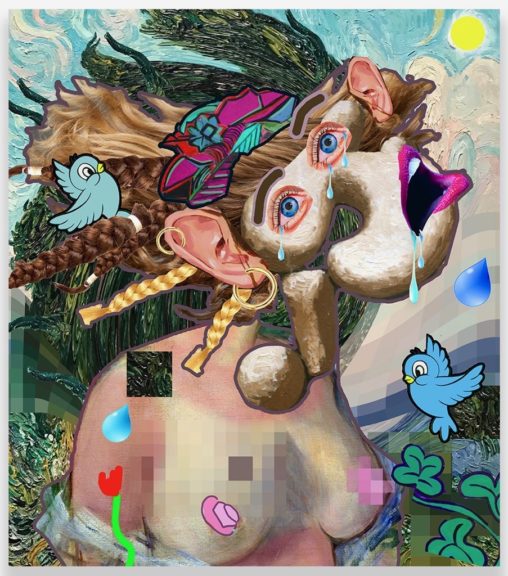
Allison Zuckerman, Sorrowing Lover, 2018, acrylic and archival CMYK ink on canvas, 60 x 53”
On May 10th, Zuckerman will be able to boast her own wing in the Pizzuti (Non-profit gallery) Collection in Columbus, Ohio, when she joins the group show Go Figure alongside artists including Nicole Eisenman, Kehinde Wiley, Derrick Adams, and Deana Lawson.
For New Yorkers looking to catch up with Allison’s work, on May 3rd, Kravets Wehby Gallery will be hosting a group show with Allison and four other women artists: Jamea Richmond-Edwards, Theresa Chromati, Naudline Pierre and Alison Blickle. Further down the line, in Spring 2020, Zuckerman will be exhibiting at Herzliya Museum in Tel Aviv, Israel.
“It’s just the diversity of acceptance of her aesthetic,” says Wehby in an attempt to explain the growing phenomenon that he helped create. “Looking at male-dominated art history-men artists fetishizing and objectifying women, especially the nude-and Allison kind of turning that on its ear, whether it’s making Picasso seductive or making the figures raw like an open nerve, not as an object, but as an active participant.”
“I call them mash-ups,” says Zuckerman of her painterly, multi-media collages. “I equate it to hip-hop, or something like Girl Talk. Each one, an homage to art history. I’m inviting the guest to dinner and then roasting them, poking fun, revering them, but not letting them get away with it.”
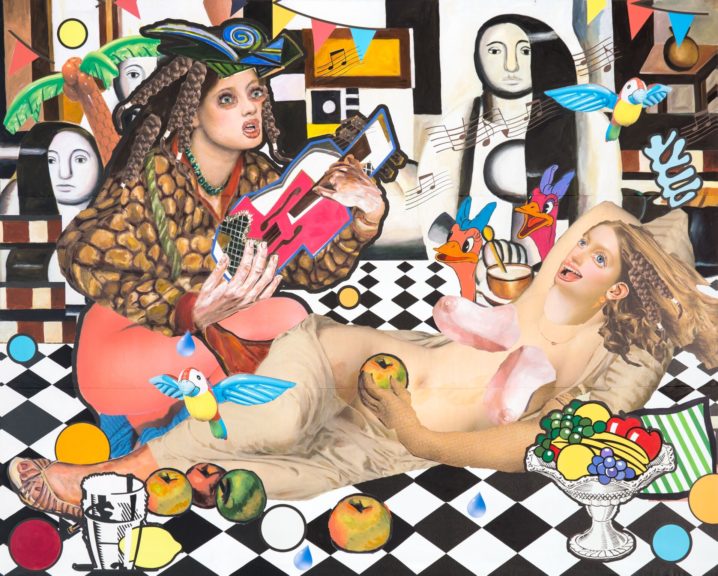
Allison Zuckerman, Serenade in the Courts, 2017, acrylic and archival CMYK ink on canvas, 155 x 193”, Rubell Family Collection, Miami, FL
Within the last month alone, Wehby says he’s turned down over fifty offers from various brands, collectors and institutions. “You can see the transparency of people’s interests,” he says. “Many people are interested just because Allison is popular, but we’ve always tried to cultivate people who are not only interested in the work but really interested in Allison.”
One of these people is the Akron Art Museum’s Chief Curator, Ellen Rudolph, who tapped Zuckerman for a solo exhibition of all new works, set to open in October this year. This will include giant, thirteen-foot panoramic tableaus and several large-scale portraits. The show will also present a sure-to-be coffee table-worthy illustrated catalogue. Wehby was happy to add that Rudolph and his wife Susie went on parallel pregnancy journeys and gave birth to their respective sons-which they both named Jake-on the same day.
It seems anecdotes like this are relayed to assure and remind Zuckerman and the art world peanut gallery at large that she’s being treated like family; her interests, her career, her happiness-all in safe hands. It might also be a strategy for mid-size galleries (who often take on all the risk of nurturing, promoting, and incubating their artists, only to see them make a leap to ‘bigger’ galleries), to protect and hold onto their young, exploding art-stars, but that’s a different article.
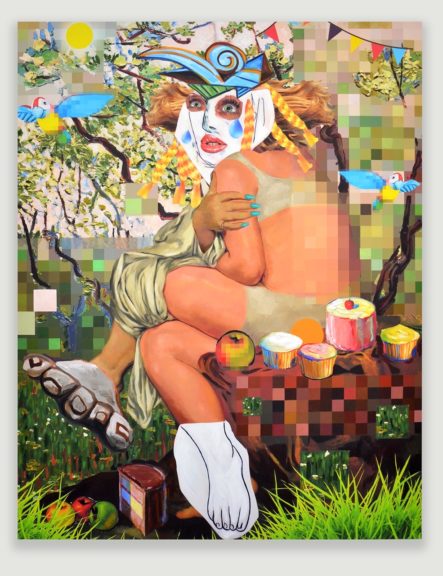
Allison Zuckerman, Woodland Muse, 2018, acrylic and archival CMYK ink on canvas, 84 x 66”
“Just in terms of how fast things are moving,” Allison interjects, seemingly used to and apparently still into people running away with the conversation around her story and unique creations, which, to be fair, are visual and thematic feasts. “How I’ve stayed centered is just showing up everyday. I stay working and keep my priorities straight. It’s rewarding to look back on a year and to see the growth-the discoveries. That’s very exiting.”
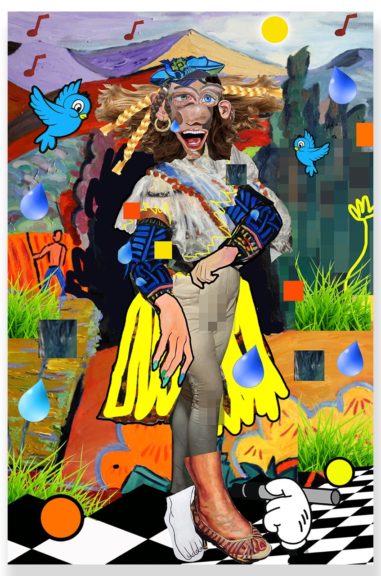
Allison Zuckerman, Napoleon, 2018, acrylic and archival CMYK ink on canvas, 80 x 53”
It’s not only rewarding to look back, it’s entertaining, especially for the uninitiated.
Allison met Marc Wehby the second week of December in 2016. At this point, she was working full time at Franklin Bowles Gallery in SoHo. “I worked from 11-7 everyday,” she says. “I would wake up early and paint, go to work, then come back and paint.”
Zuckerman was just beginning to put her work on Instagram, which still involves digitally altering images in a hyper loop addition/subtraction process. “My mentality was, ‘How are people going to see my work?’ I’m in these apartment gallery shows, fine, but it’s just not enough. But Instagram has so much reach. I felt it was the vehicle for me to be seen.”
And seen she was.
“One day, I get a message,” says the artist, cracking a wry grin. Mr. Wehby had, as the kids say, slid into her DMs (Direct Messenger tool on Instagram).
“I’m not totally sure, but that might have been my first time doing that,” says Wehby, who happened to stumble upon and reach out to Allison the day after his gallery assistant, Emma Howcroft, set an account up for him.
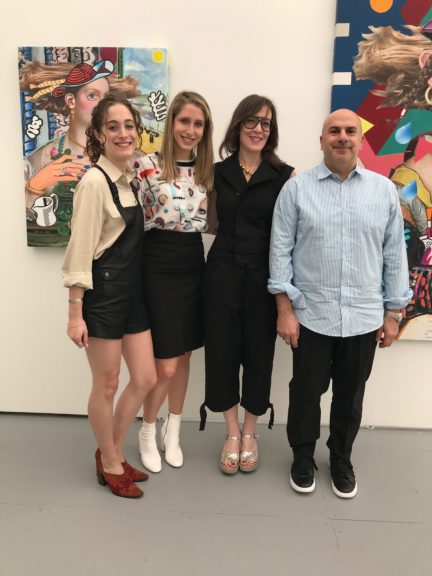
Emma Howcroft, Allison Zuckerman, Susie Kravets, Marc Wehby. Image courtesy of the artist.
“I think I was exercising,” says Zuckerman with a laugh. “I see the message. I think, ‘I know that name!’ I look up, jumped off the treadmill…I think I called my mom.”
Wehby introduced himself and asked to set up a studio visit. Though Wehby was used to selling tons of art by texting jpegs to collectors, a DM on the Gram was uncharted territory. “I felt a little creepy,” Wehby admits in good humor, drawing out one of Zuckerman’s luminous, Cheshire smiles. “I’m 48 years old. I’m going over to a young woman’s apartment by myself. My wife was a little under the weather at the time. But we hit it off!”
“When I curated the SPRING/BREAK booth [The Staging of Vulnerability, 2017], I met everyone through Instagram,” says Zuckerman, buoying her gallerist’s unsolicited method of approach. “It’s a democratic way of getting the work out there.”
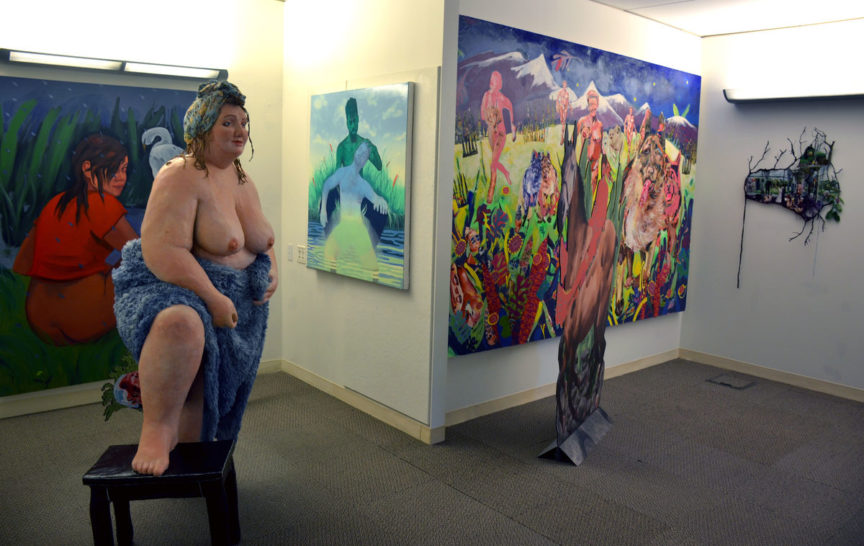
Installation view of “The Staging of Vulnerability.” Courtesy of Allison Zuckerman.
“The internet didn’t exist when Susie and I first met,” Wehby adds. “When I told the Rubells I met Allison through Instagram, I don’t think it registered for them what it was.”
Mera and Don Rubell, whose Rubell Family Collection is the biggest contemporary collection in North America, have, much like Rudolph, been fans and patrons of the Kravets Wehby program/family for quite some time.
In early January 2017, Don and Mera were in town and happened to swing by KWG to check out the group show, She Rocks (January 14 – February 18, 2017), which Zuckerman had squeezed into at the last minute. “The group show was originally men and women,” recalls Wehby, “but we nixed the guys to make room for Allison’s sculptures.”
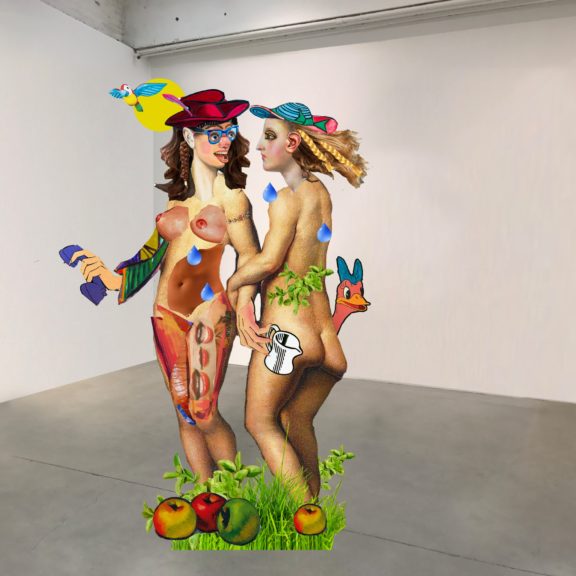
Allison Zuckerman, Two Graces, 2017, acrylic and archival CMYK ink on aluminum and polyethylene, 84 x 48”
It was a serendipitous move (sorry boys), because the Rubells were about to discover their next creative muse. Wehby remembers it like this: “The show opens, I come in a week later for lunch. Don and Mera came in to see something else. They were looking at that artist but kept asking questions about the two Zuckerman sculptures. The thing is, I had just finished having lunch with Allison.”
Standing in the middle of She Rocks and intrigued by Zuckerman’s “strange sculptures,” the Rubells asked for a studio visit. “I said, ‘Sure anytime.’ They said. ‘How about right now?’ So I called Allison right back in to the gallery,” recalls Wehby, happy to relive this moment.
Soon Allison was rushing back to her cramped and messy Williamsburg apartment, which doubled as her studio, to clean it up and make it presentable for a nice couple Wehby described only as “pretty big collectors.” Allison had no idea who the Rubells were really, let alone the fact that they were about to change her life forever.
“I remember saying, ‘They are either gonna love it or hate it. If they love it, they’ll hang out. If not, they’ll leave within five minutes.’ After an hour, I finally asked what they thought,” Wehby says.
“That’s when they asked if I had any blue tape. I did,” says Zuckermen, still brandishing some wide-eyed, residual incredulity from that moment. “Then they started putting it on the paintings.”
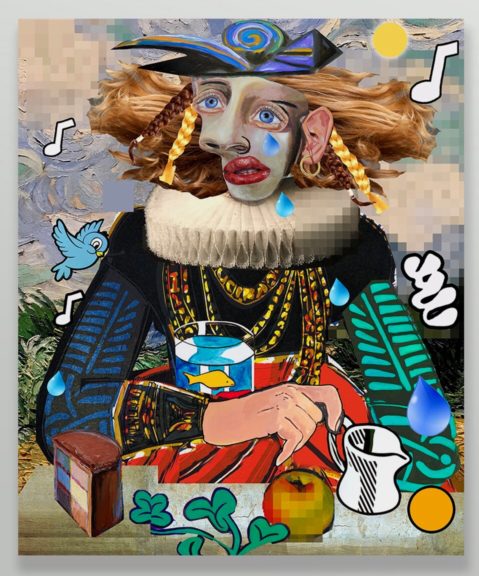
Allison Zuckerman, A Regal Morning, 2018, acrylic and archival CMYK ink on canvas, 80 x 66”
“And more paintings, and more paintings, and more paintings, until it was almost the entire studio’s worth of paintings and sculptures,” says Wehby. In their first studio visit, the Rubells purchased 22 works in total, including paintings and sculptures. “Something clicked. They saw something, both in Allison and in the work itself.”
And what does Zuckerman believe they saw? “I think potential,” she says. “They saw the space I was working in-the fervor I had.”
“If she just has the opportunity to make…” adds Wehby. “It wouldn’t just be good, it would be great! She just needed the facility.”
In late February 2017, towards the end of the run of She Rocks, Wehby offered Zuckerman a solo show at his and his wife’s gallery. This became the tellingly titled, Act Natural, which opened almost exactly one year ago.
Just a few days into May that same year, after being moved by this show, the Rubells offered Zuckerman a summer residency at their massive museum-quality exhibition space in Miami, which would ultimately culminate in a colossal solo exhibition during Art Basel, Miami Beach. This was the equally self-referential, Stranger in Paradise, (Dec. 6th 2017 – Fall 2018).
“Allison texted me when she got down there,” says Wehby, holding back a chuckle. “She said, ‘They’re gonna let me use a scissor lift!’ It shows people that a new artist who’s relatively fresh in the art world can expand her ideas to compete with the scale of the room (5,000 square feet, 20’ ceilings). It showed the art world that her potential is rather limitless. To a lot of people, that was her first exposure-the Rubells thing.”
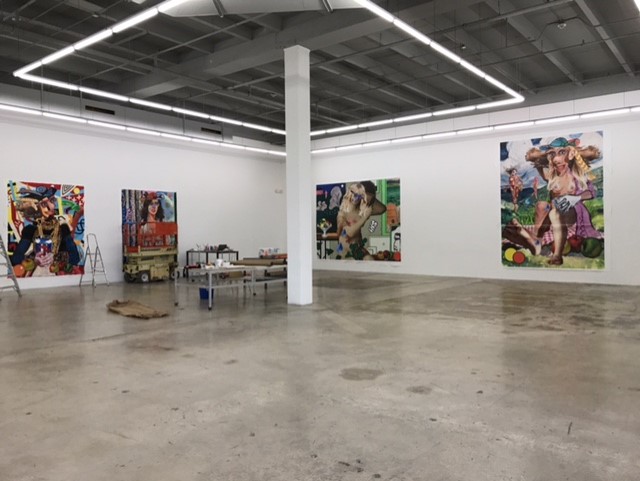
View of Zuckerman’s studio during her residency with The Rubell Family Collection.
The biggest painting in Stranger in Paradise was 18 feet wide and 15 ½ feet tall, which is truly gargantuan. These works often needed as much as seven people to get them on the wall. For Allison, the space, and the pace are intrinsic to the work, or as she frequently puts it, “form equals content.”
Zuckerman would paint in her huge studio till roughly 9pm each night, then return to Mera and Don’s gorgeous home, where she was staying throughout the residency.
“Towards the end of the residency, I was getting ready to leave, and there was a death in their family,” Zuckerman recalls. “ I didn’t want to encroach on their space at a difficult time, so I thought I would move to a hotel. They said, ‘No, no, stay here.’ Every morning we had breakfast together where we talked about art-we talked about everything.”
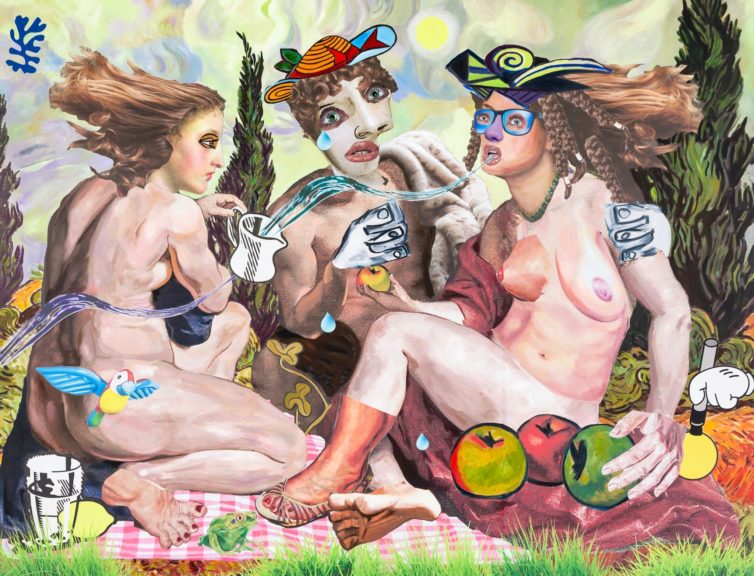
Allison Zuckerman, Creation in the Earthly Garden, 2017, acrylic andarchival CMYK ink on canvas, 122 x 160”Rubell Family Collection, Miami, FL
This is where Allison discovered the French artist Ferdinand Henri Léger, who features prominently (and now consciously) in her riotous, fractal portraits of art history. When not at breakfast, Allison remembers playing Disney’s Belle in the Rubell’s massive home-library. “It was like Beauty and the Beast, but all art books!”
Allison is still living the dream, though she spends most of the dream working in Bushwick, which I think we can all agree is considerably closer to reality.
A new, or at least expanded element in the work is Allison’s use of pixilation, which started with the idea that in printing these paintings (Allison often works out the composition digitally), everything is pixilated. “On a computer or phone screen, everything is translated through pixels,” she says. “Sort of like when Andy Warhol would make his silk screens. As to the imperfections he would say, ‘No that’s perfect, that’s what I want.’ It’s digital glitching. I harness that, but with more intention. It also plays into censorship.”
Much like her friend and peer Shona McAndrew, who was prominently featured in Zuckerman’s 2017 SPRING/BREAK booth, Allison often sees her work censored on social media, belying perhaps the best line Wehby ever served up to me regarding Zuckerman’s work at the opening of Act Natural over a year ago: “Boobs and Picasso; what’s not to like?”
“My name, when hash-tagged (#AllisonZuckerman) has been flagged on Instagram,” Zuckerman says with a warranted eye-roll.
“Good for you,” says Wehby. “That’s a badge of honor.”
“These bodies are grotesque,” she says, echoing McAndrew’s hypothesis that it’s not the nudity exactly, but the deliberately garish, jarring vibe of the unconventional imagery. “It’s intentional, this removal of the male gaze.”
The pixels are also about the nature of instant gratification anxiety and pavlovian social media despair, a modern millennial frustration. A similar theme was tackled in young painter Eric Helvie’s O, at Massey Lyuben Gallery back in September 2017. Despite the ass-kicking career, is Allison feeling frustrated or scattered? How much are these works true-self portraits?
“If I make a face on profile, of, let’s say, a Rosetti portrait with a Picasso eye with a cut-out painting I did of an ear, maybe that’s my ear,” she concedes. “But really, they’re genderized constructs. The faces become masks. They’re fluid. It’s what collage is. These paintings and sculptures are a kind of drag; art history drag! Some of it is well made, but a lot of it is shoddily made-the edges aren’t perfect. They’re performing art history.”
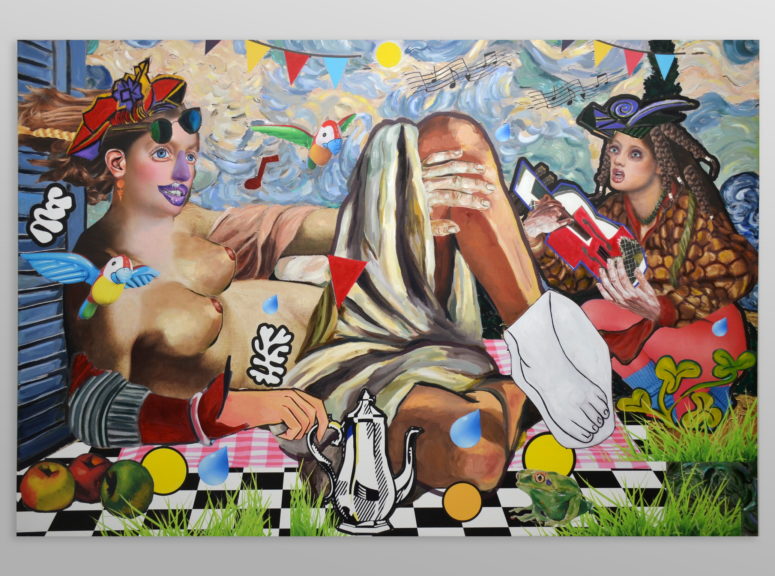
Allison Zuckerman, Bucolic Morning, 2017, acrylic and archival CMYK ink on canvas, 54 x 80”
Collage, of course, as of late, has been utilized to express the nature of complicated identities and marginalized bodies, especially so in regard to race and gender. It’s a worthy medium to relay the notion that things in life aren’t always so binary. Check out the artists in The Aesthetics of Matter, the special projects booth at Volta this year, which was curated by the super-busy Mickalene Thomas and her partner and muse, the art consultant and collector Racquel Chevremont. Take a moment to dive into the works of Wardell Milan, Rashaad Newsome and Deborah Roberts, as well as some of their recent press for a triple-shot of empathy.
“I was painting in grad school (School of the Art Institute Chicago, 2015) and I’ve always made little collages,” says Zuckerman. “I take photos of my paintings and cut them up. For me, painting has its limits. Collage doesn’t. They’re two different animals; that’s a collage.”
I’ve referred to Allison’s work many times as chimeras, literally a creature in Greek mythology composed of a fire-breathing female monster with a lion’s head, a goat’s body, and a serpent’s tail.
“It’s also like being a pirate,” she adds. “Like, he’s wearing a British Royal Navy coat, a hat from some island in the Caribbean and just putting it together. It’s about going into new and old territory, taking what you want, then moving to another territory.”
“Was it Dave Hickey who said you can break artists down into farmers and pirates?” Wehby asks rhetorically. “Like Cézanne is a farmer, Picasso is a pirate…”
Allison adds: “Didn’t Picasso say, ‘Good artists copy, great artists steal?’ ”
“What Allison does, in effect, is curation,” says Wehby, pointing to the face on a nearby painting. “Here’s Picasso, flowers from the 1930s, a dress and a body from the latter part of the 15thCentury, the background is the turn of the 20thcentury, and a face from the 1950s. The eyes she painted down at the Rubell’s. One painting equals 400 years of art history.”
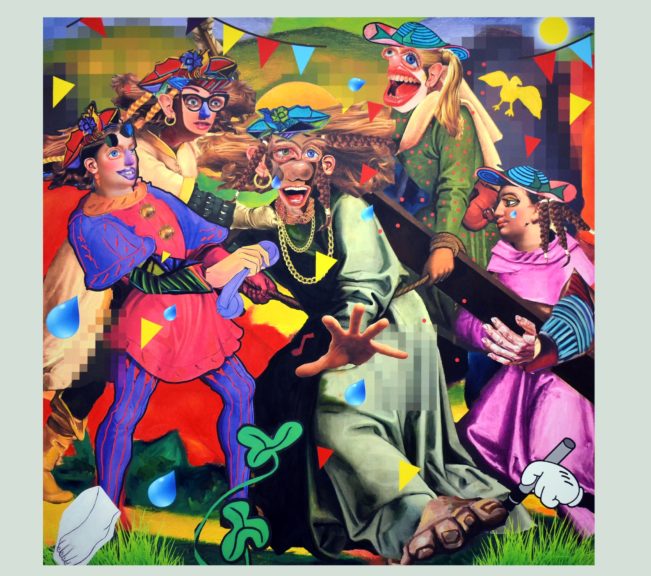
Allison Zuckerman, Garden Jubilee, 2018, acrylic and archival CMYK ink on canvas, 96 x 96”
“But it’s the ready-made; very Duchamp,” says Zuckerman. “It’s all this information at our fingertips. It’s Rauschenberg. It’s Warhol. This stuff is out there-a representation of information, which to me can be objectified. I always ask, ‘What individuates a person?’ It’s their eyes, their hands.”
“But what you do is so much more complex,” Wehby insists. “Those guys were a snapshot of their moment. Most of Rauschenberg’s references were from his lifetime.”
Zuckerman’s work could best be described, to steal a phrase from the band Arcade Fire’s latest album, as a reflection of the post-modern, “Everything Now” culture we currently live in. It should also be noted they bear some similarity to the work in pop-culture sampler, Jeff Koon’s Easyfun-Ethereal, which is about to come down in a few days (April 21st) at Gagosian’s 24th Street space. (Word on the street [Miami, New York] is Koons was rather taken by Zuckerman’s work at the Rubell’s this past December.)
As Zuckerman’s individual works become more saturated and more complex, they will inevitably explode outward once more in an endless, star-like, energy/mass fusion cycle. Deliberating on exactly where the pieces land and how they’ll be arranged is part of the fun.
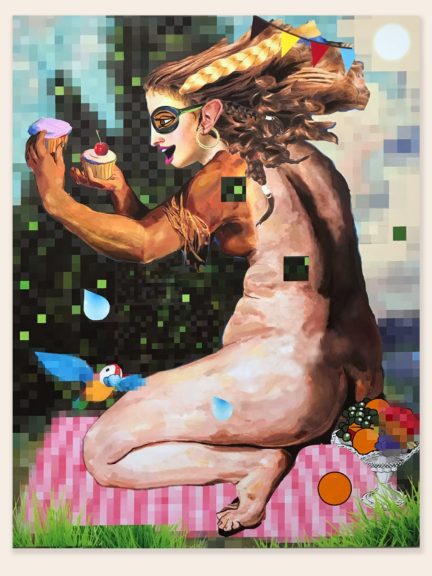
Allison Zuckerman, A Woman and Her Delights, 2018, acrylic and archival CMYK ink on canvas, 60 x 80″
“I think I want to make environments,” says Zuckerman with some refreshing giddiness and a bit of trepidation. “I want the sculptures to be the environment, sort of like that [Tom] Wesselmann show at Gagosian [Standing Still Lifes]. It would be great to design scenes from a rock opera ballet and also design the costumes. But now we’re thinking about how I can collaborate with fashion.”
“Stop there!” Wehby playfully demands before launching into a specific, off-the-record short-list of iconic, super-stylish, high profile fashion designers that have recently reached out to Allison and the folks at KWG. Wehby says they’re currently working out the details. Rest assured, they’re all no-brainer, rock star collaborations as far as vibe and aesthetic go.
“The work is so informative,” Zuckerman continues in regard to why these fashion houses are knocking like a SWAT team in the night. “People react in real time to it. It’s so theatrical. There’s some sort of spectacle built in. The sculptures occupy our space. They’re players.”
“With any artist when they’re popular, there’s a lot of possibilities,” says Wehby of his most exciting player. “But going back to that first studio visit. I wasn’t really focused on what I was seeing. I just saw that she was bursting at the seams. But now the work’s gotten bigger, gone micro, much more complex and historically referenced. With all this intrigue from brands and institutions, I think the sky’s the limit.”

Kurt McVey began his journalism career as a prolific contributor to Interview Magazine where he covered emerging and established names in the art, music, fashion and entertainment worlds. He has since contributed to The New York Times, T Magazine, Vanity Fair, Paper Magazine, ArtNet News, Forbes, Whitehot Magazine, and many more. A Long Island native, McVey is also a successful artist, model, performer, entrepreneur, and screenwriter working out of NYC.

